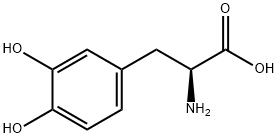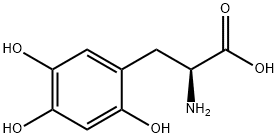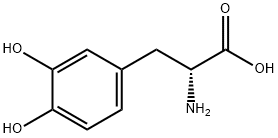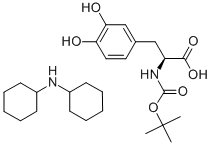DL-DOPA
Synonym(s):DL -3-Hydroxytyrosine;DL -DOPA;3-(3,4-Dihydroxyphenyl)-DL -alanine
- CAS NO.:63-84-3
- Empirical Formula: C9H11NO4
- Molecular Weight: 197.19
- MDL number: MFCD00063060
- EINECS: 200-566-0
- SAFETY DATA SHEET (SDS)
- Update Date: 2024-11-19 23:02:33

What is DL-DOPA?
The Uses of DL-DOPA
3,4-Dihydroxy-DL-phenylalanine is used as a dopamine precursor. It is also useful in organic synthesis.
What are the applications of Application
3,4-Dihydroxy-DL-phenylalanine is an immediate dopamine precursor
Definition
ChEBI: A hydroxyphenylalanine carrying hydroxy substituents at positions 3 and 4 of the benzene ring.
Synthesis Reference(s)
Journal of the American Chemical Society, 70, p. 693, 1948 DOI: 10.1021/ja01182a079
Biochem/physiol Actions
3,4-dihydroxyphenylalanine is an immediate precursor of dopamine, which is a product of tyrosine hydroxylase.
Properties of DL-DOPA
| Melting point: | 270-272 °C(lit.) |
| Boiling point: | 334.28°C (rough estimate) |
| Density | 1.3075 (rough estimate) |
| refractive index | 1.5270 (estimate) |
| storage temp. | Store at -20°C |
| solubility | Water:62.5(Max Conc. mg/mL);316.95(Max Conc. mM) |
| pka | 2.24±0.20(Predicted) |
| form | Powder |
| color | Off-white |
| Odor | Odorless |
| Water Solubility | Soluble in water, 0.5M dilute hydrochloric acid and formic acid. Insoluble in ethanol, benzene, chloroform and ethyl acetate. |
| Merck | 14,3420 |
| BRN | 3204800 |
| CAS DataBase Reference | 63-84-3(CAS DataBase Reference) |
Safety information for DL-DOPA
| Signal word | Warning |
| Pictogram(s) |
 Exclamation Mark Irritant GHS07 |
| GHS Hazard Statements |
H315:Skin corrosion/irritation H319:Serious eye damage/eye irritation H335:Specific target organ toxicity, single exposure;Respiratory tract irritation |
| Precautionary Statement Codes |
P261:Avoid breathing dust/fume/gas/mist/vapours/spray. P264:Wash hands thoroughly after handling. P264:Wash skin thouroughly after handling. P271:Use only outdoors or in a well-ventilated area. P280:Wear protective gloves/protective clothing/eye protection/face protection. P302+P352:IF ON SKIN: wash with plenty of soap and water. P305+P351+P338:IF IN EYES: Rinse cautiously with water for several minutes. Remove contact lenses, if present and easy to do. Continuerinsing. |
Computed Descriptors for DL-DOPA
DL-DOPA manufacturer
Anand Agencies
Maharashtra
Phone:91-9075014125
Whatsapp: 91-9075014125
product: 3-(3,4-Dihydroxyphenyl)-DL-alanine
New Products
(S)-3-Aminobutanenitrile hydrochloride 4-Methylphenylacetic acid N-Boc-D-alaninol N-BOC-D/L-ALANINOL Tert-butyl bis(2-chloroethyl)carbamate N-octanoyl benzotriazole 3-Morpholino-1-(4-nitrophenyl)-5,6-dihydropyridin- 2(1H)-one Furan-2,5-Dicarboxylic Acid S-2-CHLORO PROPIONIC ACID ETHYL ISOCYANOACETATE 2-Bromo-1,3-Bis(Dimethylamino)Trimethinium Hexafluorophosphate 4-IODO BENZOIC ACID 3-NITRO-2-METHYL ANILINE 1-(2,4-DICHLOROPHENYL) ETHANAMINE (2-Hydroxyphenyl)acetonitrile 4-Bromopyrazole 5,6-Dimethoxyindanone 2-(Cyanocyclohexyl)acetic acid 4-methoxy-3,5-dinitropyridine 1-(4-(aminomethyl)benzyl)urea hydrochloride 2-aminopropyl benzoate hydrochloride diethyl 2-(2-((tertbutoxycarbonyl)amino) ethyl)malonate tert-butyl 4- (ureidomethyl)benzylcarbamate Ethyl-2-chloro((4-methoxyphenyl)hydrazono)acetateRelated products of tetrahydrofuran








You may like
-
 3,4-Dihydroxy-DL-phenylalanine CAS 63-84-3View Details
3,4-Dihydroxy-DL-phenylalanine CAS 63-84-3View Details
63-84-3 -
 3,4-Dihydroxy-DL-phenylalanine CAS 63-84-3View Details
3,4-Dihydroxy-DL-phenylalanine CAS 63-84-3View Details
63-84-3 -
 DL-Dopa extrapure CAS 63-84-3View Details
DL-Dopa extrapure CAS 63-84-3View Details
63-84-3 -
 DL-dopa 95% CAS 63-84-3View Details
DL-dopa 95% CAS 63-84-3View Details
63-84-3 -
 DL-Dopa CAS 63-84-3View Details
DL-Dopa CAS 63-84-3View Details
63-84-3 -
 3-(3,4-Dihydroxyphenyl)-DL-alanine CAS 63-84-3View Details
3-(3,4-Dihydroxyphenyl)-DL-alanine CAS 63-84-3View Details
63-84-3 -
 DL-DOPA For Biochemistry CAS 63-84-3View Details
DL-DOPA For Biochemistry CAS 63-84-3View Details
63-84-3 -
 3,4-Dihydroxy-DL-phenylalanine CAS 63-84-3View Details
3,4-Dihydroxy-DL-phenylalanine CAS 63-84-3View Details
63-84-3
Statement: All products displayed on this website are only used for non medical purposes such as industrial applications or scientific research, and cannot be used for clinical diagnosis or treatment of humans or animals. They are not medicinal or edible.